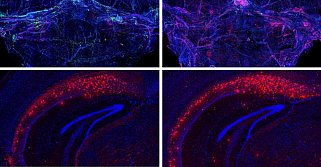
Impaired brain drainage in aging and Alzheimer’s
At a Glance
- Researchers found that the waste clearing vessels in the brain don’t work as well as mice age, leading to waste buildup.
- Improving vessel drainage in older mice enhanced their cognitive abilities, while disrupting these vessels increased buildup of Alzheimer’s disease-related proteins.
- These results suggests a possible way to combat the cognitive decline seen in aging and age-related diseases.
The body clears waste and fluid from tissues through a system called the lymphatic system. Lymph is the colorless fluid in specialized vessels that carries immune cells and waste like toxic compounds and cellular debris. Waste is filtered out of lymph as it passes through lymph nodes. The lymph then goes back into the bloodstream.
It was long thought that the brain didn't have a lymphatic system and instead relied solely on waste slowly diffusing from brain tissue into the cerebral spinal fluid. This system, managed by brain support cells called glial cells, is called the glymphatic system. Recently, researchers found conventional lymphatic vessels in the meninges, the tissue that covers the brain. These vessels surround blood vessels in the meninges, allowing waste products from the cerebral spinal fluid to drain out.
Previous studies have shown that aging can lead to protein buildup in the brain. Buildup of a protein called amyloid-beta is a hallmark of Alzheimer’s disease. A team lead by Drs. Sandro Da Mesquita and Jonathan Kipnis at the University of Virginia in Charlottesville set out to investigate the role of the brain’s lymphatic system in the buildup of proteins in the brain. Their research was supported by NIH’s National Institute of Aging (NIA). Results were published in Nature on August 9, 2018.
The team studied disrupted lymph vessels in the meninges of young mice using three different methods. Each led to decreased drainage of large molecules from the cerebral spinal fluid into lymph nodes. Mice with impaired lymphatic vessels also had reduced movement of large molecules from the cerebral spinal fluid into certain areas of the brain involved in learning and memory. Notably, mice whose meningeal lymph vessels were disrupted showed reduced spatial learning and memory abilities compared with healthy mice.
The researchers then compared the brain waste systems of older mice with younger mice. They found that the lymphatic vessels were narrower in the older mice and that molecules did not drain out of the cerebral spinal fluid into the lymph nodes as well.
The researchers boosted lymphatic function in both the younger and older mice with methods that increased the diameter of the lymphatic vessels and increased cerebral spinal fluid drainage. However, only the older mice showed improved cognitive function.
Impairing brain lymphatic vessels in two different young mouse models of Alzheimer’s disease led to higher levels of amyloid-beta deposits in the meninges. This suggested that impaired lymphatic vessels might be a previously unappreciated factor in development of Alzheimer’s disease. Therefore, the researchers performed a postmortem analysis on the brains of nine people who’d had Alzheimer’s disease and eight without the disease. They found amyloid-beta deposits in the meninges of the Alzheimer’s patients, similar to what was seen in the mice with impaired lymphatic vessels.
“It may be very difficult to reverse Alzheimer’s, but maybe we would be able to maintain a very high functionality of this lymphatic vasculature to delay its onset to a very old age,” Kipnis says.
More research is needed to determine whether altering lymphatic vessels in people would have any benefit.
—by Tianna Hicklin, Ph.D.
Related Links
- Lymphatic Vessels Discovered in Central Nervous System
- New Brain Cleaning System Discovered
- How Sleep Clears the Brain
- Mediterranean Diet May Slow Development of Alzheimer’s Disease
- Compound Repairs Features of Alzheimer’s Disease in Mice
- Brain Basics: Know Your Brain
- Immune System
- Dealing with Dementia
- Alzheimer’s Disease Fact Sheet
- Frequently Asked Questions About Alzheimer's Disease
References: Functional aspects of meningeal lymphatics in ageing and Alzheimer's disease. Da Mesquita S, Louveau A, Vaccari A, Smirnov I, Cornelison RC, Kingsmore KM, Contarino C, Onengut-Gumuscu S, Farber E, Raper D, Viar KE, Powell RD, Baker W, Dabhi N, Bai R, Cao R, Hu S, Rich SS, Munson JM, Lopes MB, Overall CC, Acton ST, Kipnis J. Nature. 2018 Aug 9;560(7717):185-191. doi: 10.1038/s41586-018-0368-8. Epub 2018 Jul 25. PMID: 30046111.
Funding: NIH’s National Institute on Aging (NIA); the Cure Alzheimer’s Fund; Owens Family Foundation; the Thomas H. Lowder Family Foundation; the Hobby Foundation; and American Cancer Society.






















.png)












No hay comentarios:
Publicar un comentario